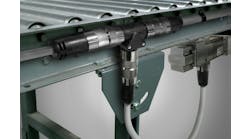The automation supply chain provides all the components necessary to create effective and innovative machinery. The first step is to examine the electrical landscape for your design. Decisions made at this juncture have implications all the way through the design, build and commissioning of the control system, so it makes sense to take a good look at what the future will look like.
Many a project has been launched only to realize that the primary power supply voltage isn’t available where your system will be installed, or, worse, you don’t have an ample power supply voltage to accomplish the intended task.
A consideration that is often overlooked is where the machine or process will, ultimately, end up. Don’t assume, just because you are building the machine in the United States, that your clients will have that same voltage available where they are. For discussion purposes, here is a small sample of residential voltage and frequencies found around the world.
|
Country |
Voltage |
Frequency |
|
Argentina |
220 V |
50 Hz |
|
Australia |
230 V |
50 Hz |
|
Canada |
120 V |
60 Hz |
|
Germany |
230 V |
50 Hz |
|
Mexico |
127 V |
60 Hz |
|
United States |
120 V |
60 Hz |
In the above example, the numbers don’t look all that different. Some are 50 Hz while, others are 60 Hz. Some are 120 V, while others are 220 V or 230 V, and one, Mexico, is 127 V. While most modern components can handle the variance between 120 and 127 V or between 220 V and 230 V, what is hiding in the weeds here is the fact that while Argentina and Australia look nearly identical, the Line and Neutral wire are reversed. That is a surprise that could have deadly consequences.
When examining three-phase industrial power options around the world, the options are even more diverse.
|
Country |
Voltage |
Frequency |
# of Wires |
|
Argentina |
380 V |
50 Hz |
3,4 |
|
Australia |
400 V |
50 Hz |
3,4 |
|
Canada |
120/208 V / 240 V / 480 V / 347/600 V |
60 Hz |
3,4 |
|
Germany |
400 V |
50 Hz |
4 |
|
Mexico |
220 V / 480 V |
60 Hz |
3,4 |
|
United States |
120/208 V / 277/480 V / 120/240 V / 240 V / 480 V |
60 Hz |
3,4 |
Note that while the United States and Canada share power grids, especially near border states, Canada has a unique voltage of 347/600 V available and most manufacturing facilities use that voltage as a default. Note also that some countries have three- and four-wire circuits not including the ground wire.
It’s extremely important to establish the available power at the end-user location before commencing the design to avoid costly errors later in the process.
Grounding is something that is often overlooked as well. On systems where people will be interacting with the equipment, the lack of an earth ground on the supply voltage to the equipment can cause serious injury or even death. This is a very serious matter. On an ungrounded system, the failure of an electrical component will direct power to the shortest path to ground. That is often found through the electrical component housing and, by virtue of the method of mounting the component to the control panel, directly into the equipment frame itself. A person touching that frame could be subjected to a shock powerful enough to stop their heart or cause a serious burn.
Always include a proper ground system, including both chassis and earth grounds, to provide adequate protection for the people operating the equipment. As a secondary measure, ensure that the power distribution system from which your control system will supplied also has a proper grounded system. This type of power distribution is called a delta-wye system where there are three power phases and a grounded neutral leg through which a dead short can travel.
The selection of a control voltage is more than a matter of taste. There are serious safety risks involved, as well. For example, prior to the invention of semi-conductors, most control systems used 120 Vac for the control voltage. This meant that not only was the power in the electrical enclosure 120 Vac but so too was the field wiring on the machine or process. Operators and technicians were exposed to those same voltages as a normal part of the work day. As anyone who has made incidental contact with an ac plug can attest, running 120 V through your body is not a desirable act.
Over the years, a number of different control voltages and components have been offered to reduce the risk of injury to personnel but none has been as effective as the advent of low-voltage dc, specifically 18-24 Vdc. Most controls designers have settled on 24 Vdc as a control voltage because it provides an adequate voltage and current to operate devices while not exposing personnel to the perils of higher voltages and the associated risk of electrical shock.
Take control
There are a number of common terms out there in the marketplace, and different types of controllers suit your application differently.
A programmable logic controller (PLC) or programmable controller is a digital computer in a more robust container. It has been adapted for the purpose of controlling a machine or manufacturing process. Some PLCs have all the inputs and outputs (I/O) all in the same housing as the controller. These are called shoebox PLCs. Other PLCs separate the I/O from the controller, and these are called modular PLCs. The choice of shoebox versus modular is determined by the size of the application, but, generally speaking, a shoebox PLC would be a good choice where there are a few inputs and outputs, while a modular PLC would suit itself to a larger project where many inputs and outputs are required.
Packages of this type are relatively limited as far as the number of inputs and outputs that can be addressed, as well as how many peripheral devices, such as additional racks of I/O, barcode scanners and encoders, can be attached to the controller.
Think of a programmable automation controller (PAC) as a PLC on steroids. While it has the same input and output capabilities as a PLC, a PAC is scalable with multiple functions (via modules) and information-enabled capabilities.
These systems utilize a common backplane to add specialty modules to independently manage important function like motion and temperature control. Multiple I/O racks can be attached and smart devices such as variable frequency drives and servo controllers can be added directly to the I/O table using industrial communications protocols to easily integrate these components.
A soft PLC has all the capabilities of a PLC/PAC but all the functions normally residing in the PLC or PAC are encapsulated in software running on a commercially available operating system.
The benefit of a soft PLC is that by running the software on an operating system, non-PLC-related programming languages can be brought into the control algorithm. Programmers now have the option to leverage the power of programming languages such as C or C++ to code complex routines that would be very cumbersome in the common ladder logic (LAD), function block (FB), sequential function block (SFC) or statement list (STL) languages available with industrial PLC or PACs.
A soft PLC also allows for the integration of third-party software into the control solution. For example, to integrate a barcode scanner into a controls package, one must set up a data exchange table of some sort to exchange key data between the PLC and the barcode scanner. This requires logging on to the barcode scanner with a laptop and setting up the function and communications to enable the PLC to talk to the barcode scanner. With the use of a soft PLC comes the ability to imbed part or all of that third-party configuration software right there in the soft PLC. The advantage to an operator or maintenance technician to be able to launch the barcode scanner configuration software right there on the HMI has obvious advantages.
Any discussion about PLCs would be incomplete without bringing up the safety controller. Early safety controllers were really little more than regular controllers painted red. While this is oversimplification, the safety controller of today is right on top of the latest in safety regulations and provides protection that conforms to EN 954-1 Category 4 and SIL 3 requirements.
EN 954-1 Category 4 circuits ensure that the safety function is always available even in the case or one or more faults, usually by employing both input and output redundancy, together with a feedback loop for continuous monitoring of the outputs.
The Safety Integrity Level (SIL) is defined as a relative level of risk reduction provided by a safety function, with SIL 4 being the most dependable and SIL 1 being the least. The Functional Safety of Electrical/electronic/programmable Electronic Safety Related Systems (IEC EN 61508) applies SIL as a measure of reliability and/or risk reduction.
Safety PLCs are programmed using graphical function blocks instead of ladder logic. The importance of this is it prevents an output from being activated if the programmer hasn’t connected all the required elements in the function blocks that make up the safety programming. For example, the programmer drags and drops various types of safety devices into the program. Space is automatically created to fit the associated function block with arrows to indicate the configuration points that must be completed before the safety circuit is complete.
Finally, unlike the compiler on a regular PLC, the programming software on a safety controller won’t produce compiled code unless all of the dots are connected. This means that you can’t produce a partially completed circuit and download it to the safety controller. With a regular PLC or PAC, as long as the code entered doesn’t produce an illegal syntax, it will allow the compiling of code that might produce an unexpected or dangerous output.
The selection of a suitable controller, at face value, might seem simple enough.
- Make a list of inputs and outputs.
- Add to that list any communications network and protocols to communicate with your system.
- Add the data input/output devices that you need in your design.
- Make sure to add the operator interface devices.
- Choose the PLC or PAC type that best suits your application, based on the I/O count.
- Pick your favorite automation supplier and give them the criteria.
Make sure the brand of controller you choose meets your requirements for the project and you can live with it for five to 10 years down the road.
The first criteria is obvious but, let’s face it, we don’t want to pick a controller today that is obsolete three years from now. What happens if we have a hardware failure? Will we or your client be able to get replacements? Let’s say you find yourself moving on to another opportunity a couple of years down the road. Will someone else be able to pick up where you left off and support the product that you chose? Most automation suppliers should be able to have an honest conversation with you about these concerns and help you make an intelligent decision.
Finally, and this is very important, if you have access to the programming software, build your PLC or PAC configuration in the software and make sure all the devices and peripherals fit your intended architecture.
Here are some things to watch for:
- know the limitations on number of I/O modules in the main or remote racks
- make sure that you can connect to a remote rack if you need one
- double-check the number of nodes that you can connect to on the chosen network architecture
- make sure that your modules suit your expected sensor and output voltage levels
- check for PNP versus NPN
- make considerations for inductive loads. Inducing a voltage can wreak havoc on a relay. Better to use a sourcing output module for devices that have inductive properties.






